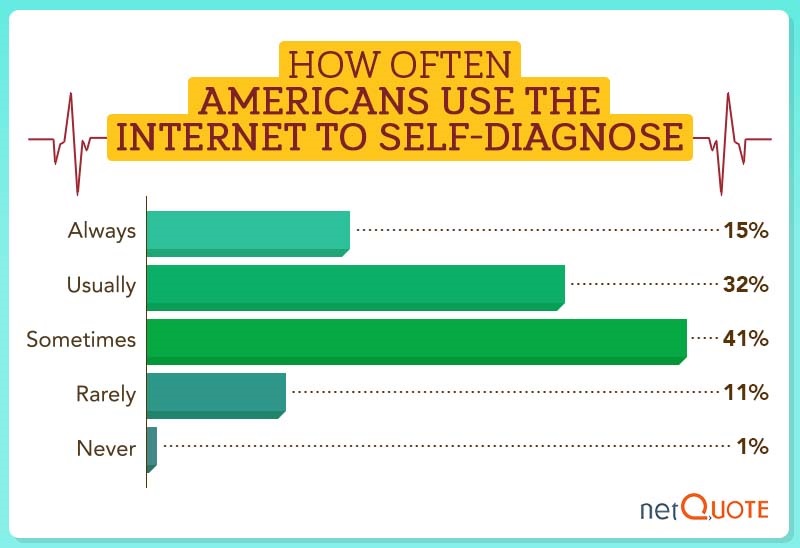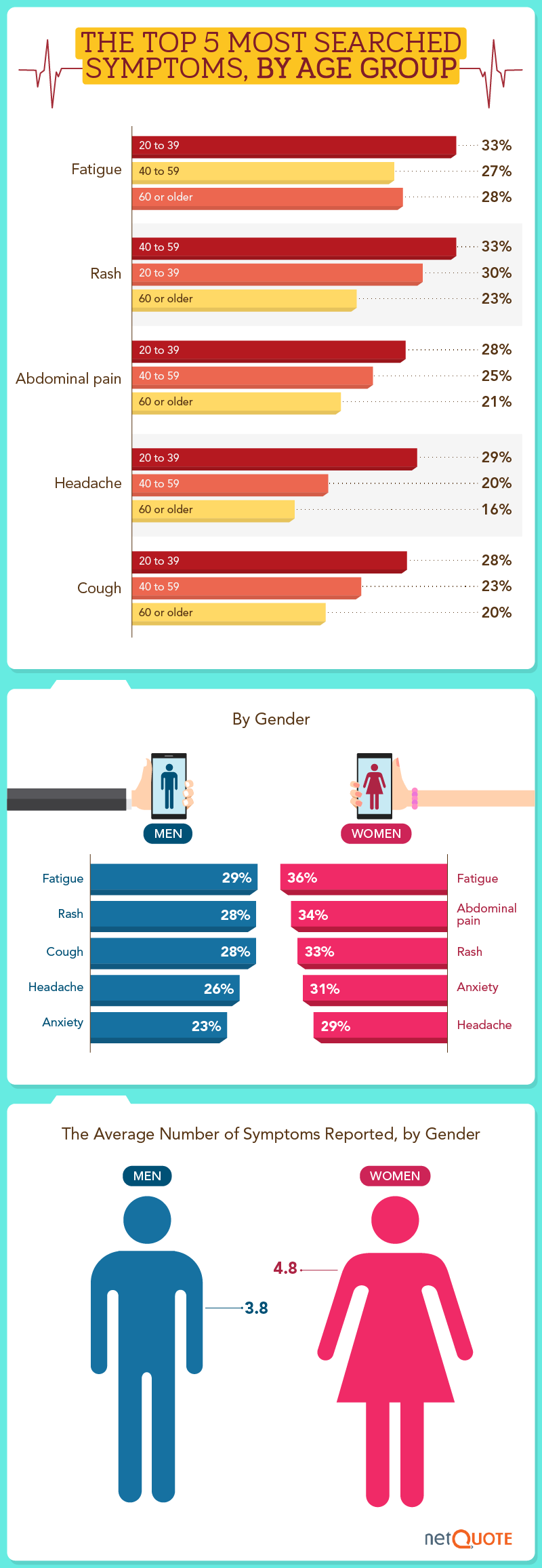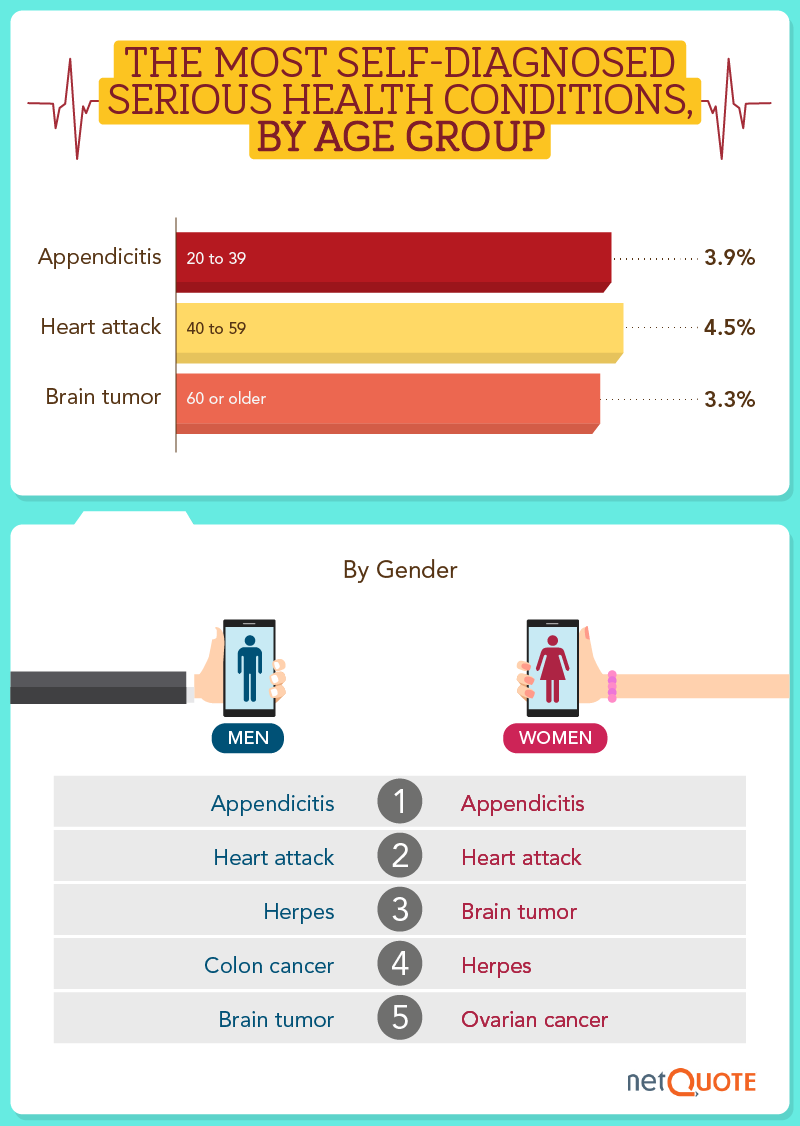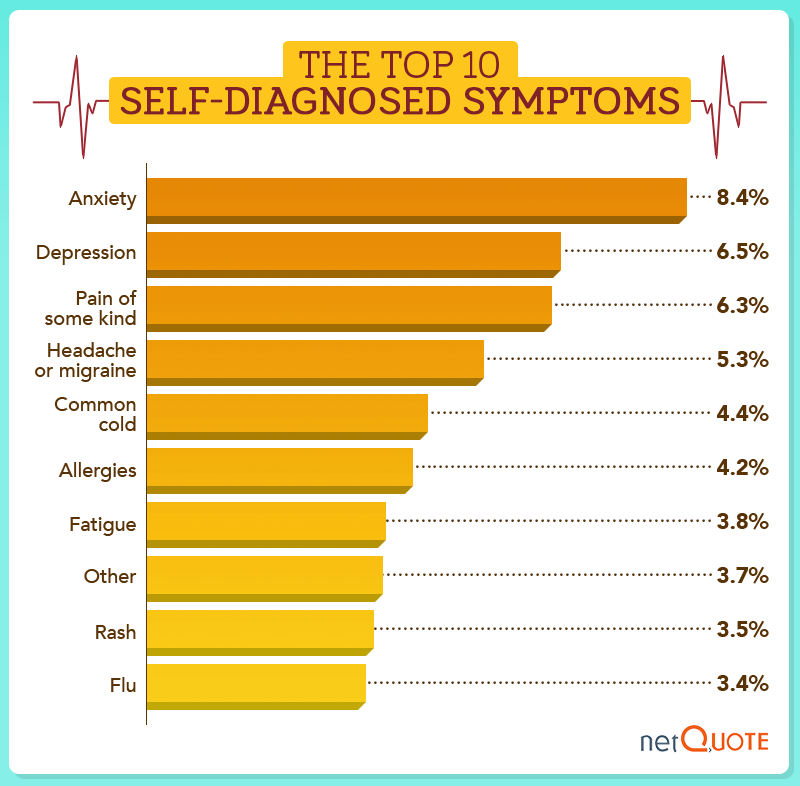Digital Hypochondria By the Numbers

It happens to the best of us: It’s late at night, and there’s a mysterious pain in your knee, your stomach is churning and your breath is shallow. You quickly turn on your computer and begin to search your symptoms, but all you get is a list of the most terrifying diseases you’ve ever heard of.
Breathing problems soon turn into bronchitis, sinusitis, asthma, and – finally – lung cancer, tuberculosis, pneumonia or AIDS. A search for “nausea causes” yields results for motion sickness, gallbladder disease, a heart attack, cancer … and a brain tumor.
It’s enough to scare a person half to death.
Which made us wonder: How often do we self-diagnose our symptoms, and how often are we right? Is our nausea really a sign of a brain tumor? We asked more than 2,000 Americans to find out.
Here’s what we learned.
Taking Health Matter Into Our Own Hands

How often do Americans use the internet to self-diagnose? As you might expect, very few people (1 percent) answered “never.” In fact, the majority answered “sometimes” (41 percent) or “usually” (32 percent).
The Most Commonly Searched Symptoms

When you go online late at night to check your symptoms, what is it you’re searching? If you’re like most of our participants, the answer is fatigue, a rash, abdominal pain, a headache, or a cough.
It turns out, rashes were a great concern for those aged 40 and 59, but survey respondents aged 20 to 39 reported the highest percentage of searches in every other category. Perhaps this is because young Americans, especially women, are very likely to be stressed out and stress and fatigue go hand in hand. Or maybe it’s that this age group — being digital natives — is more likely to search online for their symptoms.
When we split the data by gender, fatigue was the top searched symptom for men and women. However, women searched more for abdominal pain, while men researched rashes. Interestingly, women were significantly more likely to search every symptom than men, with 36 percent of women searching for fatigue and 29 percent of men doing the same.
Severe Self-Diagnosis, by Age and Gender

Headaches and rashes are uncomfortable and stressful — but when we search for a diagnosis online, we tend to hope these symptoms are just a result of overexertion or something equally easy to fix. However, what if they aren’t? What if it’s something more serious?
When we looked at the most self-diagnosed serious health conditions, appendicitis, heart attacks, and brain tumors topped the list for those aged 20 to 39, 40 to 59, and 60 or older, respectively.
When the data were broken down by gender, men and women were most likely to self-diagnose appendicitis and heart attacks, while men were more likely to diagnose themselves with herpes, and women were more likely to suspect a brain tumor.
Are We Any Good at Self-Diagnosing?

Of course, the next question we have to ask is: when it comes to self-diagnosing, are we ever right? When we pinpoint a cause for our headaches, churning stomachs, side splints and racing hearts, do we hit the nail on the head or just scare ourselves sleepless?
When we asked Americans how often they were right about their diagnoses, 60 percent said “usually” or “sometimes.” Only 15 percent were “rarely” right about their condition, and 3 percent were “never” correct.
Interestingly, 20 percent never confirmed their diagnoses.
Which Conditions Are We Most Likely to Get Right?

Perhaps we’re better at self-diagnosing than we thought … but are there certain illnesses and conditions we’re more likely to spot ourselves?
The answer is yes. Depression and anxiety were the easiest issues for men and women to self-diagnose. This was followed by the flu, headaches or migraines, allergies and general pain.
On the other end of the spectrum, itching, ADHD, tingling sensations and trouble concentrating were conditions Americans often wrongly diagnosed.
How Do We Feel When We Self-Diagnose?

The majority of Americans feel anxious when they self-diagnose (47 percent). It might just be that Americans are an anxious group of people (after all, anxiety disorders affect roughly 18 percent of people in the U.S.) Or it could be that pain, migraines and racing heartbeats are no laughing matter.
People also felt relieved (18 percent) or neutral about their self-diagnosis (24 percent).
What Conditions Are Americans Most Likely to Self-Diagnose?

As we determined, just playing Dr. Google makes many of us feel anxious. Now, let’s pair that with this tidbit: The most common self-diagnosis for a medical symptom actually is “anxiety.”
Anxiety can manifest itself in so many ways there are literally hundreds of potential symptoms out there – ranging from heart palpitations to itchy arms. Many people who suffer from anxiety especially fear the unknown — which might well lead them to spend sleepless nights trying to determine just what’s wrong in an endless cycle.
Taking Care of Our Health
Our vast access to medical information online can be useful (remember: Almost 60 percent of Americans “usually” or “sometimes” accurately diagnosed themselves). However, the most important thing you can do when experiencing pain, anxiety or strange symptoms is to seek someone more qualified than the internet: A medical professional.
It’s also important to make sure you have good health insurance coverage, something that NetQuote can help you with. We’ve done the legwork of diagnosing a number of medical professionals and can help you find the plan that fits your needs.
SOURCES
https://medlineplus.gov/ency/article/003117.htm
https://medlineplus.gov/chronicbronchitis.html
https://www.bloomberg.com/news/articles/2016-10-18/americans-work-25-more-than-europeans-study-finds
https://www.adaa.org/about-adaa/press-room/facts-statistics
https://www.theguardian.com/commentisfree/2013/mar/06/women-stress-demographic-america
http://healthland.time.com/2013/02/07/the-most-stressed-out-generation-young-adults/
https://www.healthcentral.com/article/stress-and-fatigue
Methodology
We surveyed more than 2,000 people to determine their experiences with online medical information.
Fair Use Statement
We know some people may experience an elevated heart rate, sweaty palms and dilated eyes when sharing certain media; however, there is no reason to worry. We made this project for such purposes, but we do ask that you link back to this page so our creators get the credit they deserve.
